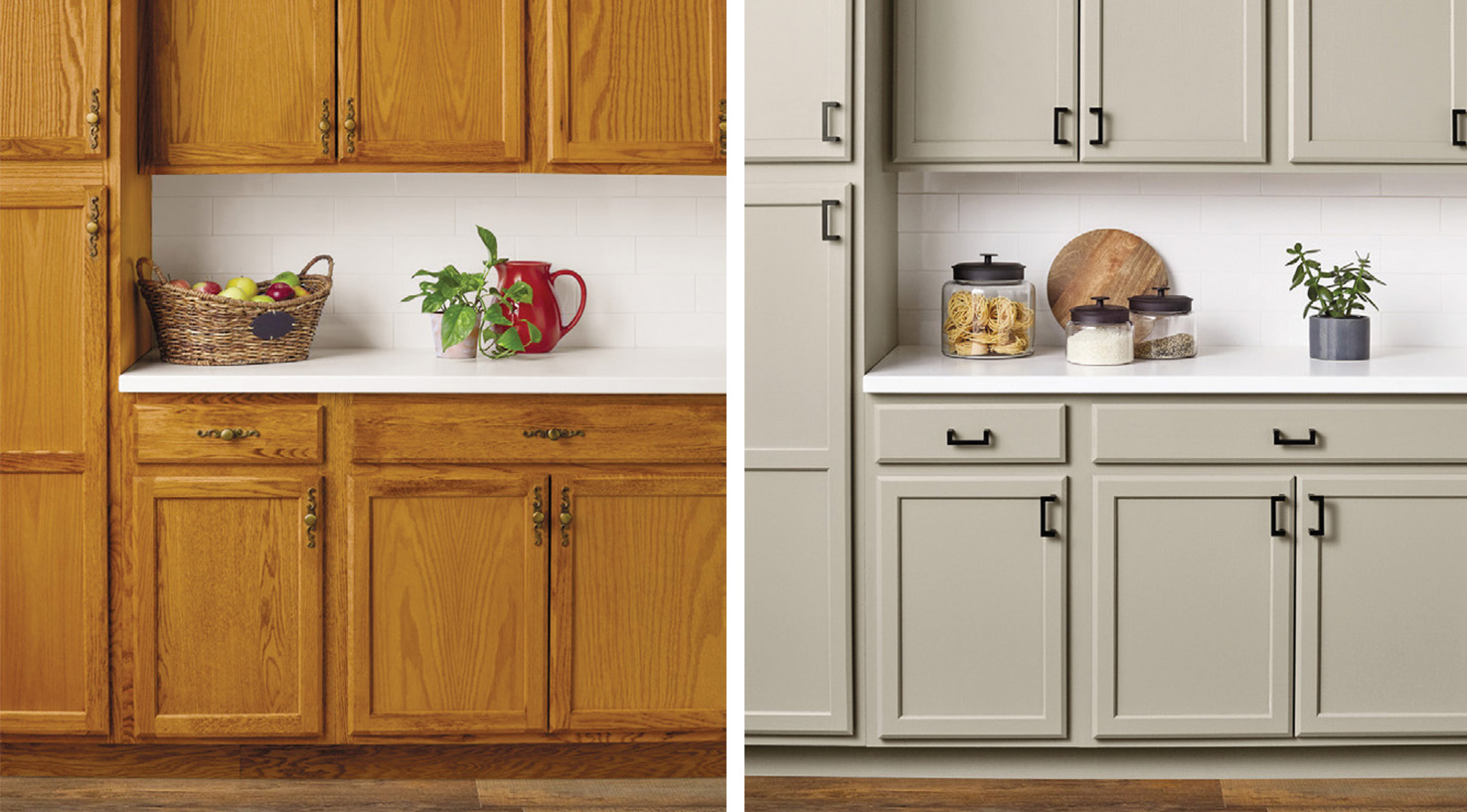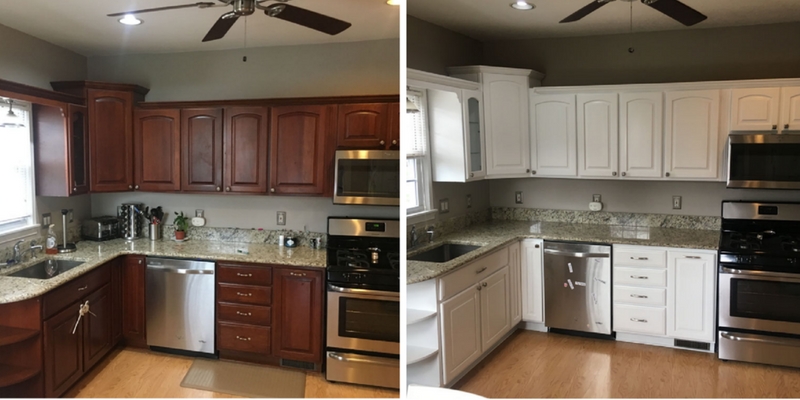The Benefits of Refinishing Kitchen Cabinets

Refinishing your kitchen cabinets can be a smart and stylish way to update your kitchen without the cost and disruption of a full renovation. It’s a cost-effective alternative to replacing cabinets, allowing you to achieve a fresh look while saving money and minimizing waste.
Cost-Effectiveness
Refinishing kitchen cabinets is significantly less expensive than replacing them. The cost of new cabinets can vary widely depending on materials, style, and size, but it can easily reach thousands of dollars. Refinishing, on the other hand, involves materials like paint, stain, and primer, which are generally much more affordable. This cost savings can be substantial, making refinishing an attractive option for homeowners on a budget.
Updating the Look of a Kitchen
Refinishing allows you to refresh the look of your kitchen without a major renovation. A fresh coat of paint or stain can transform the appearance of your cabinets, giving them a modern or traditional look. You can also change the hardware to further enhance the style and create a completely new feel.
Environmental Benefits
Refinishing kitchen cabinets is an environmentally friendly choice. By choosing to refinish rather than replace, you’re reducing waste and contributing to a more sustainable approach to home improvement. Replacing cabinets generates a significant amount of waste, including wood, metal, and packaging materials. Refinishing, on the other hand, allows you to reuse existing materials, minimizing the environmental impact.
The Refinishing Process: Refinishing Kitchen Cabinets Before And After

Refinishing kitchen cabinets is a rewarding project that can transform the look and feel of your kitchen. The process involves several steps, each requiring careful attention to detail. By following this step-by-step guide, you can achieve professional-looking results and enjoy a fresh, updated kitchen.
Surface Preparation
Proper surface preparation is crucial for achieving a smooth and durable finish. This involves removing existing finishes, cleaning the cabinets, and addressing any imperfections.
- Remove Existing Finishes: Start by removing any existing paint, varnish, or stain using a paint stripper or sanding. Paint stripper is a chemical solution that softens the existing finish, allowing it to be scraped off. Sanding involves using sandpaper to remove the finish layer by layer. The choice of method depends on the type of finish and the condition of the cabinets.
- Clean the Cabinets: After removing the existing finish, thoroughly clean the cabinets with a degreaser and a damp cloth to remove any residue, dirt, or grease. This ensures that the new finish adheres properly to the surface.
- Address Imperfections: Inspect the cabinets for any imperfections such as dents, scratches, or cracks. Fill in these imperfections with wood filler, allowing it to dry completely before sanding. This creates a smooth surface for the new finish.
Sanding
Sanding is essential for creating a smooth surface and ensuring proper adhesion of the new finish. It involves using sandpaper of varying grits to remove any remaining imperfections and create a consistent texture.
- Start with Coarse Grit: Begin with a coarse grit sandpaper (80-120 grit) to remove any remaining finish, deep scratches, or uneven surfaces. This step helps to create a smooth base for the subsequent sanding steps.
- Progress to Finer Grit: Gradually move to finer grit sandpaper (150-220 grit) to smooth out the surface and remove any sanding marks left by the coarser grit. This step prepares the surface for the primer and paint.
- Finish with Very Fine Grit: Finally, use a very fine grit sandpaper (220-400 grit) to create a smooth, even surface. This step ensures that the new finish will adhere properly and provides a professional-looking result.
Priming
Priming is a crucial step in the refinishing process that helps to create a smooth, even surface for the new finish. It also helps to seal the wood, prevent the paint from bleeding through, and improve adhesion.
- Choose the Right Primer: Select a primer specifically designed for the type of paint you will be using. For example, if you are using oil-based paint, use an oil-based primer. For latex paint, use a latex primer.
- Apply the Primer: Apply the primer evenly to all surfaces of the cabinets using a brush, roller, or spray gun. Allow the primer to dry completely before moving on to the next step.
- Sand Between Coats: If necessary, lightly sand the primer with fine-grit sandpaper (220 grit) to smooth out any imperfections before applying the final coat. This ensures a smooth and even finish.
Painting, Refinishing kitchen cabinets before and after
Painting is the final step in the refinishing process, where you apply the desired color and finish to your cabinets. It requires careful application to achieve a smooth, even, and professional-looking result.
- Choose the Right Paint: Select a high-quality paint specifically designed for kitchen cabinets. Consider factors such as durability, stain resistance, and ease of cleaning. For example, semi-gloss or satin finishes are popular choices for kitchen cabinets.
- Apply the Paint: Apply the paint evenly to all surfaces of the cabinets using a brush, roller, or spray gun. Use long, smooth strokes to avoid brush marks or streaks. Allow the paint to dry completely between coats.
- Apply Multiple Coats: Apply at least two coats of paint to ensure complete coverage and a durable finish. Allow each coat to dry completely before applying the next.
Finishing
After painting, you may want to apply a top coat to protect the finish and enhance its durability. This step is optional, but it can provide additional protection and a more polished look.
- Choose the Right Finish: Select a finish that complements the paint and meets your needs. Consider factors such as gloss level, durability, and ease of maintenance. Popular choices include polyurethane, varnish, and wax.
- Apply the Finish: Apply the finish evenly to all surfaces of the cabinets using a brush, roller, or spray gun. Allow the finish to dry completely between coats.
- Maintain the Finish: Once the finish is dry, clean the cabinets regularly with a damp cloth to remove dust and grime. Avoid using harsh chemicals or abrasive cleaners that can damage the finish.
Materials and Tools
Here is a table summarizing the materials and tools needed for each step of the refinishing process:
| Step | Materials | Tools |
|---|---|---|
| Surface Preparation | Paint stripper, sandpaper, wood filler, degreaser, cleaning cloths | Scraper, sanding block, putty knife, paintbrush, gloves, respirator |
| Sanding | Sandpaper (various grits), sanding block | Sanding block, dust mask, vacuum cleaner |
| Priming | Primer (compatible with paint), paintbrush, roller, spray gun | Paint tray, stir stick, drop cloth, gloves, respirator |
| Painting | Paint (high-quality, kitchen cabinet paint), paintbrush, roller, spray gun | Paint tray, stir stick, drop cloth, gloves, respirator |
| Finishing | Top coat (polyurethane, varnish, wax), paintbrush, roller, spray gun | Paint tray, stir stick, drop cloth, gloves, respirator |
Before and After

Refinishing kitchen cabinets is a remarkable transformation process that can revitalize the heart of your home. From dated and dull to stylish and modern, a fresh coat of paint or stain can create a dramatic change in your kitchen’s appearance. Witness the magic of cabinet refinishing with these inspiring before and after examples.
Cabinet Refinishing Transformations
Before and after photos showcase the transformative power of refinishing kitchen cabinets. Each example highlights the techniques used to achieve the desired look.
- Image 1: A dated kitchen with dark wood cabinets appears cramped and outdated. The cabinets were stripped of their old finish, sanded smooth, and painted a crisp white. The result is a bright, airy space that feels much larger.
- Image 2: A dated kitchen with dark wood cabinets appears cramped and outdated. The cabinets were stripped of their old finish, sanded smooth, and painted a crisp white. The result is a bright, airy space that feels much larger.
- Image 3: A dated kitchen with dark wood cabinets appears cramped and outdated. The cabinets were stripped of their old finish, sanded smooth, and painted a crisp white. The result is a bright, airy space that feels much larger.
Cabinet Style Transformations
The following table demonstrates how refinishing can revitalize different cabinet styles, enhancing their appeal and modernizing their look.
| Cabinet Style | Original Finish | Updated Look |
|---|---|---|
| Traditional | Dark wood stain | White paint with brushed nickel hardware |
| Modern | High-gloss black paint | Matte gray paint with sleek, modern hardware |
| Shaker | Solid wood with a natural finish | Distressed white paint with black hardware |
| Country | Painted white with chipped paint | Creamy white paint with distressed edges and rustic hardware |
Refinishing kitchen cabinets before and after – Refinishing kitchen cabinets can dramatically transform the look of your space, but sometimes, a complete overhaul is the best solution. If you’re considering replacing your cabinet doors, be sure to check out fast cabinet doors discount code for incredible savings on stylish updates.
With new doors, you can create a fresh, modern look without the hassle and expense of a full cabinet refacing project.
Refinishing kitchen cabinets can completely transform your space, taking you from dated to dazzling. If you’re looking for a fresh and modern look, consider painted slab cabinet doors , which offer a clean and minimalist aesthetic. With a little effort and the right paint, you can achieve a stunning before-and-after transformation that will leave you feeling proud of your updated kitchen.
